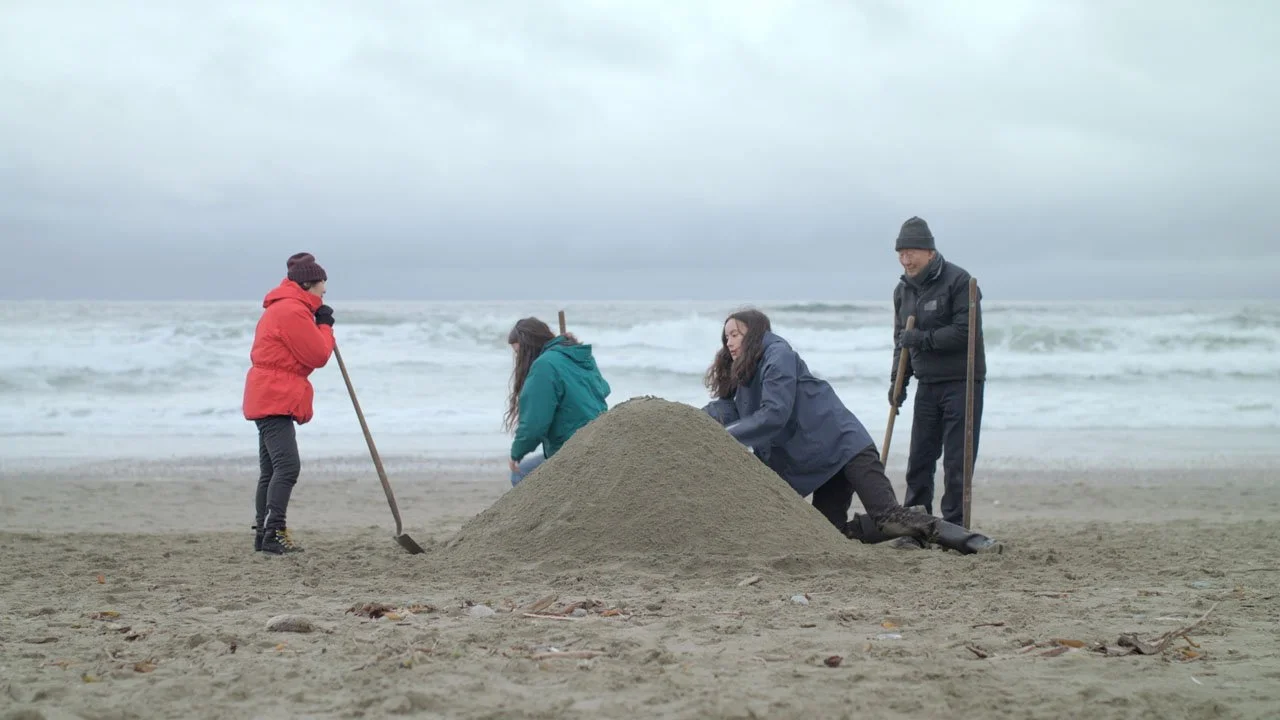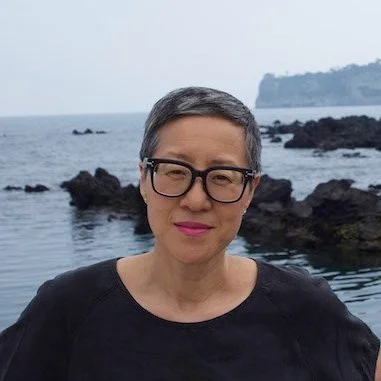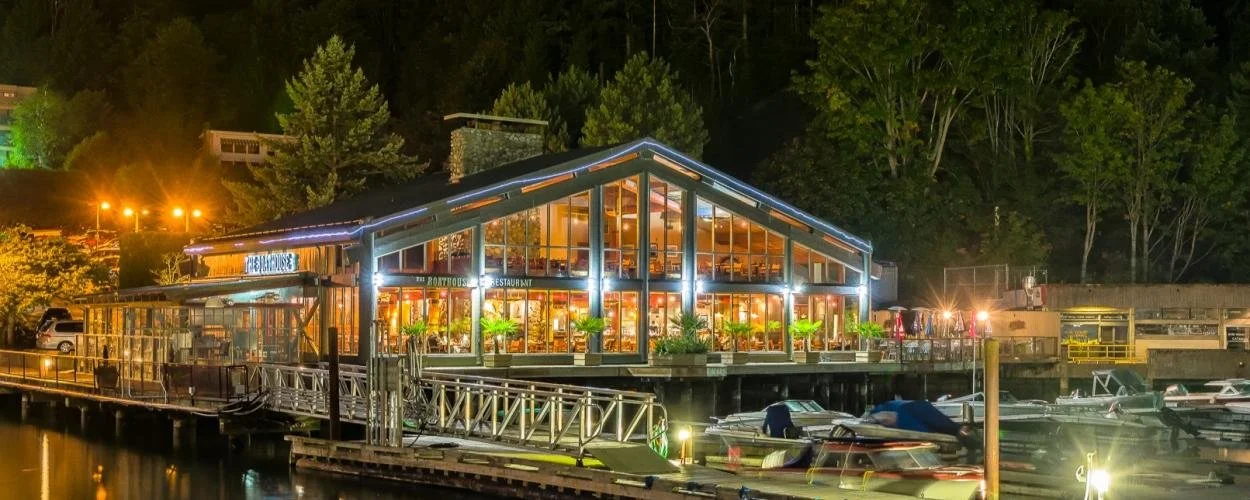At the Vancouver Art Gallery, Jin-me Yoon's new works explore interconnections between identity, history, nature, and more
Video- and photo-based works created in western Canada and South Korea take form in the flowing, curving About Time exhibition
Jin-me Yoon’s Long View (chromogenic print), Collection of the Vancouver Art Gallery, Acquisition Fund
Jin-me Yoon: About Time is at the Vancouver Art Gallery until March 5, 2023
WATER AND IDEAS FLOW through the videos, photographs, and other installations in Jin-me Yoon’s exhibition of new work at the Vancouver Art Gallery. Figures crane-dancing on the mud flats of the North Vancouver waterfront give way to footage of abandoned fishing boats on coastal South Korea; turn a corner and you’ll see a video set on a vast swath of beach by Radar Hill, south of Tofino.
Past and present interweave, and bodies interact with landscapes scarred by history—Yoon’s ideas criss-crossing the Pacific in a dreamlike, associative manner.
Fittingly, even the physical space of the gallery has been altered to achieve that flow, the entire upper-floor space outfitted with curved walls; videos sit in expansive rooms with photographs, and you can see from one space into another.
“I want you to flow through these spaces because these issues are interconnected,” the artist explains at the just-opened Jin-me Yoon: About Time, featuring work from the past 10 years—all showing in Vancouver for the first time. “I didn't want little black boxes that you walk in and out of.”
“Decisions were very specific around curved walls, instead of dark boxes and closed rooms,” explains the show’s curator, Diana Freundl. “Life is that way, and everything moves in a very organic way, and everything is interconnected. So it was very conscious—but also very hard!”
The result is a poetic exhibit—four years in the making—that gives videos and their accompanying photos and sculptural pieces a chance to breathe.
This is also an opportunity to catch up on the practice of the South Korean-born, Vancouver-based artist, who immigrated to Canada as a child. Since 1989 her work has been exhibited across the country and around the world in solo and group exhibitions. But 2022 has seen heightened recognition, with Yoon winning this country’s prestigious Scotiabank Photography Award, and the Musée d’art de Joliette launching a major retrospective exhibition.
Trained in psychology at UBC, Yoon went on to get her BFA from the then-Emily Carr College of Art in 1990, followed by an MFA from Concordia University. Today she teaches at SFU School for the Contemporary Arts.
Yoon has long explored identity, memory, place and displacement through her photo-, performance-, and video-based practice. In past decades, her pieces have often featured herself. In her best-known photographic series, “Souvenirs of the Self (Rocky Mountain Bus Tour)”, the artist created postcard images picturing herself at iconic tourist spots in Banff; she was cheekily questioning Canadian identity and her role, as an Asian-Canadian woman, within that.
Jin-me Yoon’s Long View (still), single-channel video. Courtesy of the Artist
But her practice has shifted markedly in this newer work. Yoon tells Stir she has a “finer attunement” to the way histories are entangled, and a greater concern for a world that’s fractured and facing environmental crisis.
As for the pieces she creates, she says she’s taking longer to contemplate them in the studio. “I give myself over to learn about the work and what it is that I’m trying to do,” she explains.
Yoon describes her process as a mix of deep historical research, travel, chance encounters with people, and solo contemplation in the studio.
“I’m a pretty prolific researcher and reader,” she tells Stir in an interview at the gallery. “I’m not just interested in facts or chronological history. Telling a more expanded version of history requires a break with the concept of linearity. So I’m really interested in how history is told.
“I’m concerned about how you move forward, and I don't think you can move forward without history,” she emphasizes. “But the artist part of me is associative. I think of it as a more fluid, dynamic process.”
That associative process comes into play in one of the most formally striking and most recent works in the exhibit, called Turning Time (Pacific Flyways).
Eighteen video screens dangle from the VAG rotunda, each featuring a different young person from the Korean diaspora, performing a traditional, meditative Korean crane dance on Maplewood Flats. The videos switch between intimate closeup and wide shots, while a soundtrack captures birdsong and the far-off roar of trains and industrial extraction that happens down the waterway. Yoon is interested in a new generation, perhaps less traditionally connected to Korea than she was (with several of the subjects biracial). But the location also places those ideas of migration and the diasporic experience purposefully on unceded Tsleil-Waututh land—not to mention the complicated history of the former industrial site.
Like so many of the works here, Yoon is looking both backward and forward. “There's a kind of reason and holding a place for possibility, but not having to reveal everything at once,” she hints. “How do we form community? This is linked to Turning Time.
“There’s an attention to presence in their bodies and this land-consciousness shift that we need—to make time to slow down and be present,” she adds. “There’s intimacy, and there’s action.”
The work connects directly with a series of inkjet prints in the adjoining room: A Group for 2067 (Pacific Flyways) features the same Korean-Canadian youths draped in vivid Korean saekdong fabrics, in colours that traditionally symbolize survival and resilience. These portraits, too, are set against the greenery of Maplewood Flats on Tsleil-Waututh lands. Yoon sees it as a work of hope, and a call toward a new inclusivity for the next generation—one that encompasses land rights and ecological conscience. (The series also connects directly to Yoon’s 1996 photo work A Group of Sixty-Seven, featuring 67 members of the Korean-Canadian community in front of Lawren Harris’s painting Maligne Lake, Jasper Park and Emily Carr’s Old Time Coast Village; like the more recent series, the title played on the iconic-Canadian Group of Seven.)
That flows into an installation that includes a wider array of generations—including Yoon’s own late father, as well as her children. Accompanied by framed photographs, the single-channel video Long View features three generations of her family digging a hole on a vast Pacific Rim National Park beach, occasionally stopping to gaze across the ocean—presumably, to their ancestral continent. Again we have a site whose natural beauty belies a complicated history: in this case, one disrupted by military training; nearby to Radar Hill sits a memorial to the Canadian soldiers who fought in the Battle of Kapying in the Korean War.
The diggers’ task is interrupted, sometimes by glitching archival and oceanic imagery, and then the appearance of a mysterious shadow figure. It’s a perfect example of the way Yoon brings together historical, military, ecological, personal, and even surreal or spiritual threads—in this case, on the very edge of the Pacific Rim. In a meaningful touch, she invites visitors to watch the video projection while sitting on a pyung-sang—a traditional low, Korean gathering bench, but in this case made out of reclaimed cedar.
In a nearby room is Mul Maeum (“Water, Mind-heart”), one of the video pieces that Yoon shot in South Korea. The haunting three-channel work juxtaposes the rubble of an abandoned fishing village with the ghosts of weathered, wooden fishing boats, tipped over on dry land; elsewhere military jets cut through the skies over a bird estuary.
The destroyed fishing village was part of the fallout of the building of Saemangeum, the world’s longest, and possibly most controversial, seawall, located near the ancestral lands of Yoon’s mother. Another site is Gangjeong village on Jeju Island, where the construction of a naval base has disrupted the area around sacred Gureombi rock. And the third location is the richly bio-diverse Demilitarized Zone (DMZ) separating North and South Korea. Together, the images form a deep meditation on the effects of extraction and military economies on both communities and natural marine environments.
Echoing that projection are the scroll-like prints Still So (Mul Maeum), depicting jangseungs (Korean totem poles) made by activists protesting the seawall in Saemangum. They’re pictured hauntingly in the negative, swimmers and surfers blithely enjoying the water beneath totems to lost ecosystems.
“Really the aesthetic is collage—the collision of meaning, accidents, and serendipity,” Yoon observes of her juxtapositions. “It’s to make sure I don't have a static vision.”
There is much more to discover in this web of interrelating works—a vast quantity of creations by a prolific artist who’s guided by a deep concern for society and the planet. The themes are vast, but what Yoon is expressing takes a relatable, simpler human scale: the need for connection between people as a way of moving forward.
“When we encounter each other, our ancestors meet, our ghosts meet, and it becomes: How then do we have a conversation?” she says. “How then do we move forward in a broken world? This is a time of incredible urgency. And this is what gives me the strength to do the work.”















